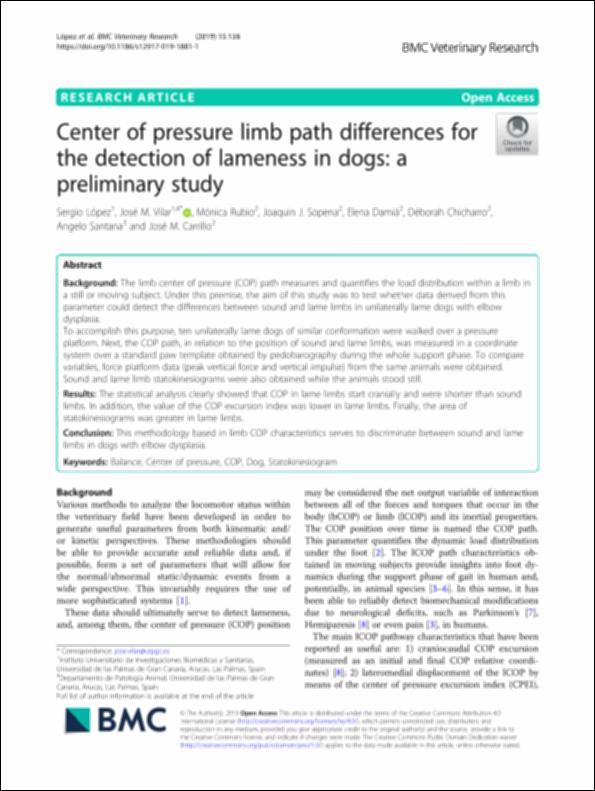Por favor, use este identificador para citar o enlazar este ítem:
http://hdl.handle.net/10637/10767Center of pressure limb path differences for the detection of lameness in dogs : a preliminary study
| Título : | Center of pressure limb path differences for the detection of lameness in dogs : a preliminary study |
| Autor : | López Barbeta, Sergio. Vilar, José M. Rubio Zaragoza, Mónica. Sopena Juncosa, Joaquín Jesús. Damiá Giménez, Elena Chicharro Alcántara, Deborah Santana, Angelo Carrillo Poveda, José María. |
| Materias: | Perros - Locomoción.; Dogs - Locomotion.; Lameness in dogs - Diagnosis.; Presión.; Animal mechanics.; Mecánica animal.; Cojera en los perros - Diagnóstico.; Miembros anteriores - Heridas y lesiones - Diagnóstico.; Animal locomotion.; Locomoción animal.; Miembros posteriores - Heridas y lesiones - Diagnóstico.; Arm - Wounds and injuries - Diagnosis.; Leg - Wounds and injuries - Diagnosis.; Pressure. |
| Editorial : | BioMed Central. |
| Citación : | López, S., Vilar, JM., Rubio, M., Sopena, JJ., Damiá, E., Chicharro, D. et al. (2019). Center of pressure limb path differences for the detection of lameness in dogs : a preliminary study. BMC Veterinary Research, vol. 15 (8 may), art. 138. DOI: https://doi.org/10.1186/s12917-019-1881-1 |
| Resumen : | Background: The limb center of pressure (COP) path measures and quantifies the load distribution within a limb in a still or moving subject. Under this premise, the aim of this study was to test whether data derived from this parameter could detect the differences between sound and lame limbs in unilaterally lame dogs with elbow dysplasia. To accomplish this purpose, ten unilaterally lame dogs of similar conformation were walked over a pressure platform. Next, the COP path, in relation to the position of sound and lame limbs, was measured in a coordinate system over a standard paw template obtained by pedobarography during the whole support phase. To compare variables, force platform data (peak vertical force and vertical impulse) from the same animals were obtained. Sound and lame limb statokinesiograms were also obtained while the animals stood still. Results: The statistical analysis clearly showed that COP in lame limbs start cranially and were shorter than sound limbs. In addition, the value of the COP excursion index was lower in lame limbs. Finally, the area of statokinesiograms was greater in lame limbs. Conclusion: This methodology based in limb COP characteristics serves to discriminate between sound and lame limbs in dogs with elbow dysplasia. |
| Descripción : | Este artículo se encuentra disponible en la página web de la revista en la siguiente URL: https://bmcvetres.biomedcentral.com/articles/10.1186/s12917-019-1881-1 |
| URI : | http://hdl.handle.net/10637/10767 |
| Derechos: | http://creativecommons.org/licenses/by/4.0/deed.es |
| ISSN : | 1746-6148 (Electrónico) |
| Fecha de publicación : | 8-may-2019 |
| Centro : | Universidad Cardenal Herrera-CEU |
| Aparece en las colecciones: | Dpto. Medicina y Cirugía Animal |
Los ítems de DSpace están protegidos por copyright, con todos los derechos reservados, a menos que se indique lo contrario.


